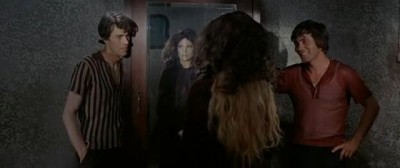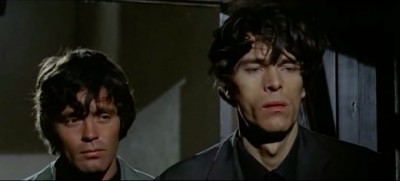| Reviews & Columns |
|
Reviews DVD TV on DVD Blu-ray 4K UHD International DVDs In Theaters Reviews by Studio Video Games Features Collector Series DVDs Easter Egg Database Interviews DVD Talk Radio Feature Articles Columns Anime Talk DVD Savant Horror DVDs The M.O.D. Squad Art House HD Talk Silent DVD
|
DVD Talk Forum |
|
|
| Resources |
|
DVD Price Search Customer Service #'s RCE Info Links |
|
Columns
|
|
|
Violent Life, A
Inexplicable surrealism and sharp social, sexual and political commentary intermingle in One 7 Movie's nice DVD transfer of Sergio Citti's debut film Ostia (1970). Curiously, the title for the American DVD release of Ostia is A Violent Life, which is the title of an Italian crime film from 1962 based on a novel by Pier Paolo Pasolini, the notorious filmmaker, poet, and journalist who wrote the script for Ostia. Pasolini's own confrontational films were drawn equally from his Catholic belief system and Communist ideology. Ostia will appeal to those who wish to dig deeper into Pasolini's body of work because the film has remained relatively obscure in the US.
Ostia/A Violent Life was filmed in the real-life Roman slum where Pasolini was murdered five years after the film was released and opens with two Anarchist/petty criminal brothers, Bandiera (Laurent Terzieff) and Rabbino (Franco Citti) visiting their catatonic mother in a decrepit mental hospital. In the next sequence, the two brothers and a small group of thieves find the listless nude body of a young blond woman named Monica (Anita Sanders) lying in a field, appearing like the apparition of a ghostly Bridget Bardot or Catherine Deneuve. The woman's ethereal, sudden and dream-like presence in the lives of the two brothers is reminiscent of some of the best Surrealist works of Luis Bunuel, who was near the end of his career in 1970. Monica seems to be less a of a real woman than a cipher who evokes the movie's critique of the Catholic church, political ideologies, its themes of jealousy, crime and poverty, and incest. The gang of criminals who accompany Rabbino and Bandiera during their discovery end up raping Monica while the two brothers get drunk in another room.

A sense of disdain and suspicion towards politically far-Left ideology is expressed by the decision to show the boys' father as a drunken, obnoxious lout who awakens his family in the middle of the night to sing propaganda songs about dying for the Socialist cause and executing the kings who rule over the working class.
Ostia's critique of Leftist beliefs through its depiction of the boys' father as a cruel drunk is complicated and made intriguing by screenwriter Pasolini's role as one of Italy's most outspoken political activists, a role that most believe led to his murder. Pasolini was a man who railed against the ruling class in most of his work, yet depictions of antagonism of the bourgeoisie are often tinged with a cynicism towards Radical points of view.
The brothers' celibacy is alluded to early in the film when they refuse to take part in the sexual assault of Monica and becomes more apparent when the two men befriend and platonically grow attached to her. On a boating trip, both men look away when Monica decides to swim in the nude. Tensions arise in their relationship when Monica visits the two brothers in prison halfway through Ostia/A Violent Life and she decides that Bandiera will be her husband when they are released. Their previously celibate, platonic relationship with Monica begins to go sour when unexpected jealousy rises to the surface.

Similar to Pasolini's own films, Ostia is sharply critical of Catholicism but also handles its criticism of the church in a comical tone. The soundtrack is filled with beautiful ecclesiastical music that is often juxtaposed against the squalid setting of Ostia. During the sequence where Bandiera and Rabbino are in prison, a priest (played by Celestino Campognoni, the desperate everyman from Visconiti's Neorealist masterpiece The Bicycle Thief) takes inmates' confessions and in these scenes the solemn, spiritual ecclesiastical sounds are replaced by circus music.
As the screenwriter and producer, it is entirely possible that Pasolini had far-reaching creative control over Ostia. Director Sergio Citti's visual style is marked by beautiful wide shots, deep perspectives, and well-balanced compositions that are reminiscent of Pasolini's final film, Salo, released just five years later and immediately after his death. That film also confronted its viewers with themes surrounding authority, the church, and sexual deviance with a similar visual style. Ostia/A Violent Life, despite being directed by a different filmmaker, is still a good primer for Pasolini's work because it addresses many of the themes that he explored in his own movies.
The DVD
Video: One 7 Movies preserves the 2.35:1 aspect ratio of the film and the earth-tone color scheme of Ostia/A Violent Life are soft and pastel-like. On HD TVs, the deep focus cinematography is clear and has transferred nicely to disc, preserving many small details and a sense of the physical textures of Ostia's mostly rural, poverty-stricken setting. The soft dreaminess of its visual style contributes to the film's Surrealist bent.
Audio: One 7 Movies has preserved Ostia's original Mono sondtrack. However, the sometimes flat audio does not detract from experiencing the film. The ecclesiastical choir music that accompanies most of the soundtrack still sounds beautiful despite a lack of aural dimension. Similar to many Italian films of its era, the dialogue and sound effects were post-dubbed. There are English subtitles to accompany the disc's Italian audio track.
Extra Features: The Ostia/A Violent Life DVD has no special features.
Final Thoughts:
Ostia/A Violent Life is worth viewing just to watch the widescreen cinematography. Despite a flat audio track, the film's sound is still engrossing, due in large part to the stirring religious music used in its soundtrack. Thematically and visually, then-first-time director Sergio Citti made a film that was consistent not only with Pasolini's filmmaking but also the political and social climate of turbulent 1970s Italy. Pasolini fans in the US may enjoy Ostia/A Violent Life as a rare film in Pasolini's larger body of work. If you happen to find a copy of Ostia/A Violent Life, hold on to it, because its greatness does not justify its obscurity to US audiences.
|
| Popular Reviews |
| Sponsored Links |
|
|
| Sponsored Links |
|
|
| Release List | Reviews | Shop | Newsletter | Forum | DVD Giveaways | Blu-Ray | Advertise |
|
Copyright 2024 DVDTalk.com All Rights Reserved. Legal Info, Privacy Policy, Terms of Use,
Manage Preferences,
Your Privacy Choices | |||||||













